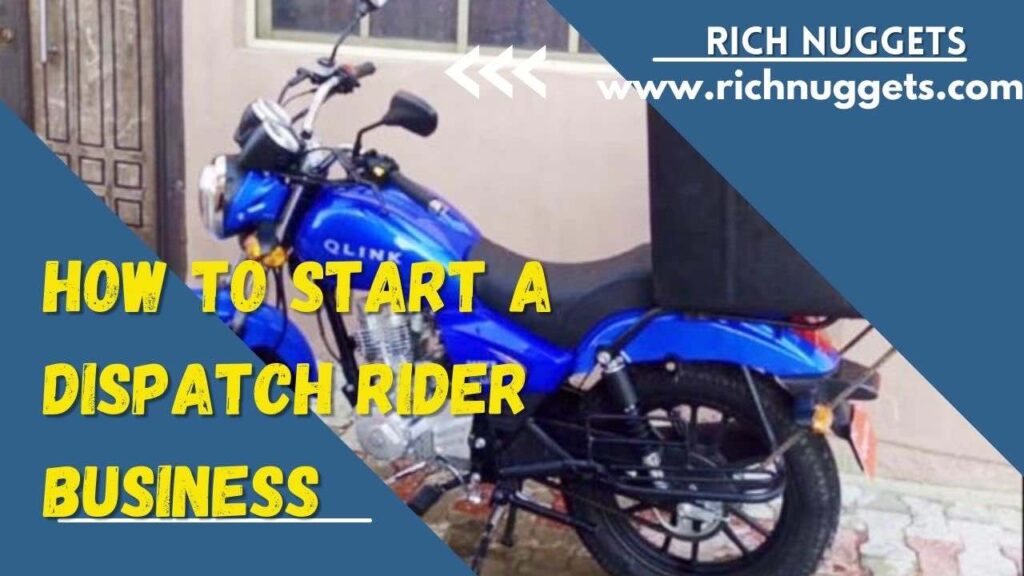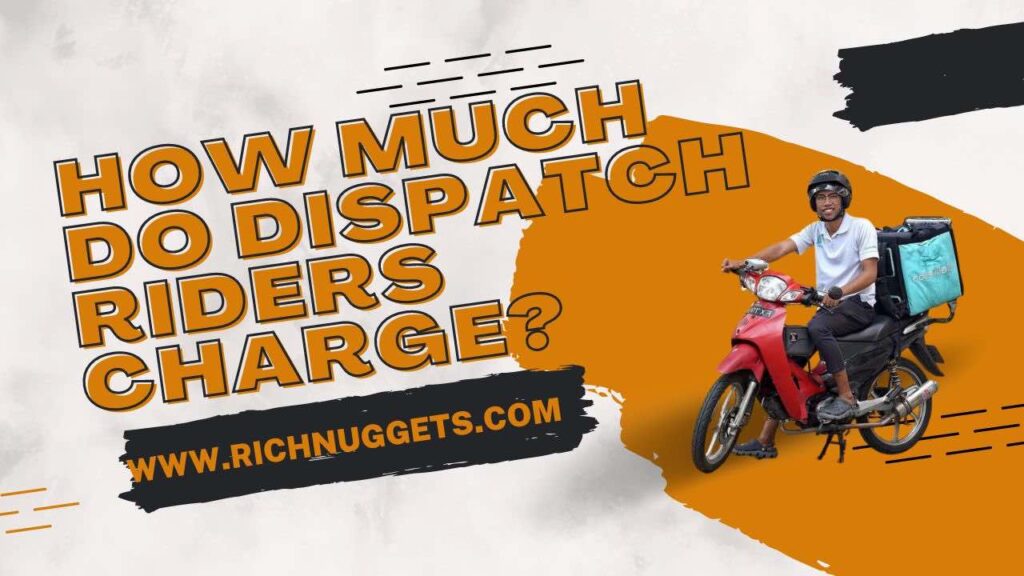
A Dispatch Rider Business is a type of courier service that uses motorcycle riders (dispatch riders) to deliver various types of items, documents, parcels, and goods to specific destinations. These businesses are commonly found in urban areas where traffic congestion and limited parking can be challenging for traditional delivery methods.
The dispatch rider business is a profitable venture in Nigeria due to the high demand for its services. This high demand stems from its ability to provide a fast and efficient delivery service, particularly for small packages and time-sensitive documents. They are commonly used by individuals and organizations to transport items such as letters, legal documents, small packages, food deliveries, and other goods that require quick and reliable transportation.
The process usually involves customers contacting the dispatch rider business either through a phone call, mobile app, or website to request a delivery. The dispatch rider is then assigned to pick up the item from the sender and deliver it to the intended recipient at the specified location.
Table of Contents
How much do I need to start a dispatch business?

To start a dispatch rider business in Nigeria, the initial investment required is N400,000 Naira. This amount encompasses the purchase of a motorcycle and the dispatch box attached to it. It’s essential to note that this N400,000 constitutes the starting cost for an independent dispatch rider business, where you, as the rider, will be solely responsible for running the operations.
However, if your aspirations involve setting up a larger dispatch rider business, where you intend to own multiple bikes and employ staff, the minimum capital needed would be at least N2 million Naira, with the precise amount varying based on the scale of your intended operations.
Our focus in this article is on how to start a dispatch rider business in Nigeria, but if you want to know how to start a logistics business in Nigeria, then click here.
Difference between Dispatch Rider Business and the Logistic Business
A Dispatch Rider Business and a Logistics Business are both involved in the transportation and delivery of goods, but they differ in their scope, scale, and the services they offer.
Below is a tabular representation of the difference between the dispatch rider business and the logistic business;
| S/n | Aspect | Dispatch Rider Business | Logistics Business |
|---|---|---|---|
| 1 | Scope and Scale | Small-scale, localized deliveries | Large-scale, comprehensive logistics |
| 2 | Services Offered | Quick delivery of small items | Full supply chain services |
| 3 | Transportation Vehicles | Motorcycles or small vehicles | Trucks, ships, airplanes, etc. |
| 4 | Geographic Reach | Limited to a specific area | National or international operations |
I hope this table has helped you understand the differences more clearly!
How to Start a Dispatch Rider Business

Below are the steps to follow when starting a dispatch rider business;
1. Market Research and Planning
Market research and planning” is the first essential step when starting a dispatch rider business not the purchasing of your dispatch bike.
Doing market research before entering a dispatch rider business is very important. This step is essential because it is conceivable that your current location may exhibit minimal or even no demand for dispatch riders.
Several factors could contribute to this situation, such as a dominant logistics firm holding over 90% of the market share, unsupportive government policies in the state or chosen city, or a lack of awareness and trust among people regarding entrusting their items to a stranger for delivery. Regardless of the specific hindrance, one thing becomes evident – you must seek an alternative location with more favorable conditions to establish and thrive in your dispatch rider business.
Basically, Conducting market research means gathering data and insights about the demand for dispatch services in the specific area or region where you intend to operate your business. This research helps you understand the dynamics of the market, potential customers, and their needs.
In conducting market research for your dispatch rider business, these areas of focus must be highlighted.
- a. Demand Analysis
- b. Competitor Analysis
- c. Target Audience
The next thing to do after conducting market research is to create a simple business plan of 2 to 3 pages.
Business planning outlines your business’s objectives, strategies, and financial projections.
A well-researched and comprehensive business plan is essential for guiding your dispatch rider business in the right direction and increasing its chances of success in the competitive market.
2. Legal Requirements
Despite the dispatch rider business being smaller in scope compared to a logistics business, a dispatch rider business must still comply with the legal requirements of the states in which it operates.
In complying with the legal requirement, the following documents must be obtained;
- Business Name Registration from the Corporate Affairs Commission (CAC)
- Driver’s License
- Courier or Delivery Service License
- Insurance Coverage
Complying with these requirements ensures that your business operates within the legal framework and avoids potential penalties or legal issues.
3. Motorcycle and Equipment
This is when you need to get the motorcycles or scooters and safety gear for your dispatch rider business. Without the motorcycle and equipment, you can not be called a dispatch rider in the eyes of the public especially those in need of the services of dispatch riders.
Apart from the motorcycle there are other important items (equipment) that most be acquired for professionalism, efficiency and safety in this business. They are;
- Safety Gear (Helmets, Reflective Jackets, Gloves, knee and elbow pads, safety boots, and rain gear to keep your riders safe).
- Mobile Phone
- Computer
- Dispatch box
Lastly, ensure that your dispatch riders have suitable motorcycles or scooters that is; reliable, fuel efficiency, high capacity, and easy to maintain.
4. Hiring and Training
If your capital can’t accomodate this scope of dispatch rider business where you will need to employ staff and buy multiple bikes, you can skip this step.
But if your goal is to employ at least one staff to be an additional rider, this step is for you.
When it comes to hiring and training of employees, you must not leave it to chance rather you must have a format for selecting only the best emplyees that are ready to work with your dispatch riders business.
The training aspect is to provide them with the necessary training to perform their duties efficiently and professionally.
Here is what to look out for when hiring your employees;
- Good Driving Records
- Knowledge of the Area
- Communication Skills
- Reliability and Punctuality
While for a comprehensive training these are areas they must be knowledgeable about;
- Safe Riding Practices
- Customer Service
- Specialized Delivery Software
- Emergency Protocols
By hiring competent and responsible dispatch riders and providing them with thorough training, you create a skilled and reliable team capable of delivering excellent service to your customers.
5. Establish Delivery Routes and Zones
Even though there is demand for dispatch riders in your state or city, it is also good to establish delivery routes and zones.
This will help you strategically plan and organize the areas your dispatch riders will serve, as well as design efficient delivery routes to ensure timely and cost-effective deliveries. It also emphasizes the importance of using technology (Map App eg google Maps) to optimize routes based on real-time traffic conditions.
An additional advantage of establishing your riders’ routes and zones is to avoid areas that are known to be criminal zones.
By establishing delivery routes and zones and optimizing them for efficiency, customers will receive their deliveries promptly, and your business can save on operational costs like fuel and time.
6. Insurance Coverage
Insurance coverage is a crucial aspect of protecting your dispatch rider business, your riders, and your customers from potential financial liabilities arising from accidents or damages that may occur during deliveries. Insurance provides a safety net in case of unfortunate incidents and ensures that your business can handle any unexpected expenses or legal claims. In insuring your dispatch rider business is fully covered by an insurance company three type of insurance must be obtained;
- Business Insurance
- Riders’ Insurance
- Liability Insurance (For example, if a rider accidentally collides with a pedestrian or damages someone’s property while making a delivery, liability insurance will cover the costs of legal claims and medical expenses from the third party).
Having insurance coverage for your business and riders is not only a legal requirement in many regions but also a responsible business practice. It protects your assets and ensures that your dispatch rider business can continue its operations smoothly even in the face of unexpected challenges.
7. Set Pricing and Payment Options
This step involves determining the cost of your delivery services and providing customers with convenient payment methods.
In determining the pricing structure for your delivery services. factors such as; distance, Urgent delivery, package size and weight, and competitor analysis, must be considered.
while on the other hand, the payment options could include diverse payment options to accommodate the preferences of your customers. The common payment options in a dispatch riders business are;
- a. Cash Payments
- b. Credit/Debit Cards
- c. Digital Wallets
- d. Invoice and Bank Transfers
- e. Online Payment Platforms
By setting competitive pricing and offering multiple payment options, you enhance the customer experience and increase the likelihood of repeat business.
8. Marketing and Promotion
The marketing and promotion step in the dispatch rider business involves creating a strategic plan to raise awareness about your dispatch rider business, attract potential customers, and encourage them to use your delivery services.
This marketing strategy may combine both online and offline channels to reach a broader audience. Or just an offline channel if your target audience is local.
Examples of Online marketing strategies are; Website, social media, signing up on online platforms that connect customers to riders, and paid advertising
Examples of Offline marketing strategies are; Flyers and brochures, partnerships with other businesses (eg eateries, boutiques, local transportation companies, and spare parts sellers), and branded vehicles and uniforms
Apart from implementing these marketing strategies, offering special promotions or Discounts can also attract new customers. For example, you can provide discounted rates for first-time customers or introduce loyalty programs to reward repeat clients. Limited-time offers create a sense of urgency and encourage potential customers to take action.
Regularly evaluate and adjust your marketing strategy based on performance data to maximize its impact and continuously attract new customers to your dispatch rider business.
How much do dispatch riders charge?

On average, dispatch riders charge between N1,000 to N5,000 for their services, whether in Lagos, Edo, Abuja, or any other city in Nigeria. The charges are subject to variation based on several factors, including the location (with higher-priced areas incurring higher charges), the distance of delivery, the urgency of the delivery, the package size and weight, and the additional specific services provided by the dispatch rider.
KEY RESOURCES:
- How to start a small scale business in Nigeria
- How to Register a Business Name in Nigeria in 7 Easy Steps
- How to Get a Loan to Start a Business from the Government
READ ALSO:
Final Thoughts on Starting a Dispatch Rider Business
Starting a dispatch rider business will also require office space. But if your capital can not accommodate such expenses, you can start from your house.
In conclusion, starting a dispatch rider business in Nigeria is a profitable venture due to the high demand for fast and efficient delivery services. By conducting thorough market research, complying with legal requirements, and investing in reliable motorcycles and safety equipment, you can establish a successful dispatch rider business.
By following these steps and maintaining a focus on customer satisfaction, your dispatch rider business has the potential to thrive in the competitive Nigerian market and meet the growing demand for reliable and efficient delivery services.
If you have any questions or contributions, leave them in the comment section below 👇 .
Remember to subscribe via Email or by turning on the Bell 🔔 Notification icon, to get updated directly on your device when new articles are published
How do I start a dispatch business from home?
You can start a dispatch business from home by conducting market research and planning, meeting the legal requirements, acquiring motorcycle and equipment, hiring and training staff (optional), establishing delivery routes and zones, obtaining insurance Coverage, setting pricing and payment options, and finally market and promote your dispatch riders business.
Discover more from StartBizEasy
Subscribe to get the latest posts to your email.





